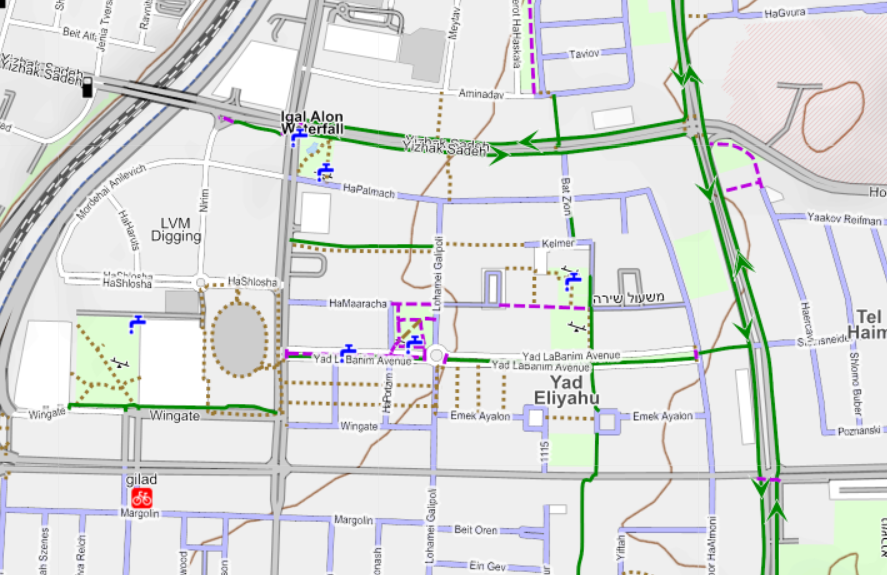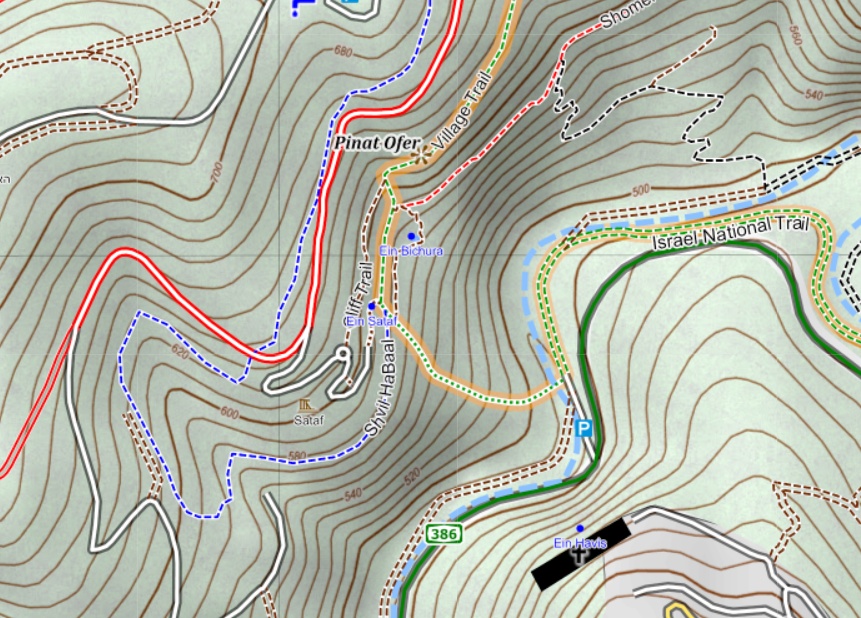Difference between revisions of "Israel Hiking and Biking Maps"
(add categories) |
|||
| (8 intermediate revisions by one other user not shown) | |||
| Line 4: | Line 4: | ||
The project was initiated in 2014 to provide hikers and bikers with access to open maps of Israel. It also aimed at involving more volunteers in the local Open GIS community. | The project was initiated in 2014 to provide hikers and bikers with access to open maps of Israel. It also aimed at involving more volunteers in the local Open GIS community. | ||
=== Implementation === | === Implementation === | ||
| − | We developed an interactive [https://israelhiking.osm.org.il website]. It | + | We developed an interactive [https://israelhiking.osm.org.il website]. It provides six maps (basemaps and transparent overlays in 2 languages) based on open data (OSM + SRTM elevation data) and an interface for planning and sharing routes. The maps and interface were developed using open-source code. The development effort is coordinated in a dedicated [https://github.com/IsraelHikingMap GitHub page]. |
| − | an interface for planning and sharing routes. The maps and interface were developed using open-source code. The development effort is coordinated in a dedicated [https://github.com/IsraelHikingMap GitHub page]. | + | === Benefits: === |
| − | + | ==== For hikers ==== | |
| − | === | ||
Previously, hikers relied on prohibitively-priced government-issued printed maps of hiking paths in Israel. This limited the access of economically disadvantaged populations to nature trails. Now everybody can use the free maps on smartphones or print them out. | Previously, hikers relied on prohibitively-priced government-issued printed maps of hiking paths in Israel. This limited the access of economically disadvantaged populations to nature trails. Now everybody can use the free maps on smartphones or print them out. | ||
| − | === | + | ==== For bikers ==== |
Our map marks bike paths in cities and safer streets for cycling, and the interface prioritizes these when auto-routing planned bicycle rides. Together these allow cyclists to | Our map marks bike paths in cities and safer streets for cycling, and the interface prioritizes these when auto-routing planned bicycle rides. Together these allow cyclists to | ||
plan safer commuting routes within dense cities in Israel. For the benefit of MTB riders, grading of mountain bike trails and height profiles are also shown. | plan safer commuting routes within dense cities in Israel. For the benefit of MTB riders, grading of mountain bike trails and height profiles are also shown. | ||
| + | ==== For OSM mappers ==== | ||
| + | The project has allowed unskilled users to easily add data to OSM and Wikipedia by making the update process more accessible and tuned to their needs. It improved mapping coverage significantly in Israel since it began. | ||
| + | ==== For opensource GIS developers ==== | ||
| + | The open code we generated contains several useful procedures for developers of similar projects. These include identification of GPX sections missing from OSM, merger of identical points of interest in OSM and wikipedia and more. | ||
| + | We are beginning to migrate to docker and to micro services architecture that would allow micro services we develop to be easily re-used [https://github.com/IsraelHikingMap/GPSBabelWebAPI (example)]. | ||
| + | The algorithms we developed and documented can be translated to any language needed in order to be used in other places. | ||
| + | Every operation can be used by API HTTP calls and is documented with swagger. This enables, for example, to use this API to geosearch entities from OSM including relations. | ||
=== Volunteers === | === Volunteers === | ||
| Line 29: | Line 35: | ||
More volunteer work is needed to translate documentation and to adapt the infrastructure to world-wide coverage. | More volunteer work is needed to translate documentation and to adapt the infrastructure to world-wide coverage. | ||
We would need funds to buy server space on a globally-dispersed service. | We would need funds to buy server space on a globally-dispersed service. | ||
| + | ===Budgetary needs=== | ||
| + | We are seeking a funding source for US$7,500 that would allow us to scale the project internationally. | ||
| + | |||
| + | [[Category:Local Chapters]] | ||
| + | [[Category:Israel Chapter]] | ||
Latest revision as of 11:22, 25 July 2018
Initial Aims
The project was initiated in 2014 to provide hikers and bikers with access to open maps of Israel. It also aimed at involving more volunteers in the local Open GIS community.
Implementation
We developed an interactive website. It provides six maps (basemaps and transparent overlays in 2 languages) based on open data (OSM + SRTM elevation data) and an interface for planning and sharing routes. The maps and interface were developed using open-source code. The development effort is coordinated in a dedicated GitHub page.
Benefits:
For hikers
Previously, hikers relied on prohibitively-priced government-issued printed maps of hiking paths in Israel. This limited the access of economically disadvantaged populations to nature trails. Now everybody can use the free maps on smartphones or print them out.
For bikers
Our map marks bike paths in cities and safer streets for cycling, and the interface prioritizes these when auto-routing planned bicycle rides. Together these allow cyclists to plan safer commuting routes within dense cities in Israel. For the benefit of MTB riders, grading of mountain bike trails and height profiles are also shown.
For OSM mappers
The project has allowed unskilled users to easily add data to OSM and Wikipedia by making the update process more accessible and tuned to their needs. It improved mapping coverage significantly in Israel since it began.
For opensource GIS developers
The open code we generated contains several useful procedures for developers of similar projects. These include identification of GPX sections missing from OSM, merger of identical points of interest in OSM and wikipedia and more. We are beginning to migrate to docker and to micro services architecture that would allow micro services we develop to be easily re-used (example). The algorithms we developed and documented can be translated to any language needed in order to be used in other places. Every operation can be used by API HTTP calls and is documented with swagger. This enables, for example, to use this API to geosearch entities from OSM including relations.
Volunteers
So far the design and coding of the maps and user interface relied on a core of three volunteers who communicate and meet regularly. We are helped by several occasional contributors. All development has been pro-bono.
Mapping community
The project has attracted a devout community of mappers to contribute to open GIS data. Our supporters exchange ideas, tips and suggestions in a Facebook group (Hebrew) with over 3000 members. A face-to-face training meeting and a mapping party has been organized and well-attended in 2017 and 2018.
Impact
Our site now attracts around 40,000 views per month. Many more use our open maps within various navigation apps or presented in collaborating websites. This open alternative now pushes government agencies to rethink their closed-garden approach to geo-data, and release some of it under open licenses.
International scaling effort
We would like the site to go international. The benefits the site provides are by no means regionally-restricted. We have already provided an English version of the maps and interface. More volunteer work is needed to translate documentation and to adapt the infrastructure to world-wide coverage. We would need funds to buy server space on a globally-dispersed service.
Budgetary needs
We are seeking a funding source for US$7,500 that would allow us to scale the project internationally.

